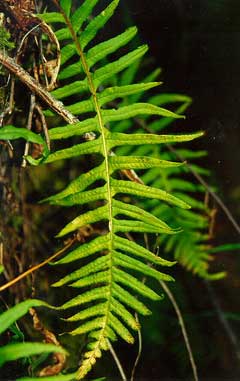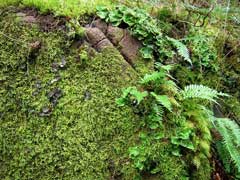 |
|
www.fs.fed.us |
 |
| http://www.flickr.com/photos/93452909@N00 |
Translate this page:
Summary
Polypodium glycyrrhiza,
Licorice fern root has a sweet, liquorice-like flavour. Due to its texture, it is thin, fibrous, and largely inedible. However, the root is commonly chewed for its pleasant taste.
Licorice fern is a hardy plant valued for its ornamental qualities. It can tolerate short periods of drought and direct sunlight but thrives in bright, filtered light, making it well-suited to shaded woodland environments. The plant can be grown on dry stone walls.
The liquorice fern is native to the temperate regions of the Pacific Northwest, including Alaska, the Aleutian Islands, British Columbia, California, Idaho, Kamchatka, Oregon, Washington, and Yukon.
Harvesting: Roots are harvested throughout the year, but they are typically gathered in spring to early summer when they are most tender.
Physical Characteristics

 Polypodium glycyrrhiza is a FERN growing to 0.5 m (1ft 8in) by 0.5 m (1ft 8in) at a medium rate.
Polypodium glycyrrhiza is a FERN growing to 0.5 m (1ft 8in) by 0.5 m (1ft 8in) at a medium rate.
See above for USDA hardiness. It is hardy to UK zone 7. The seeds ripen from November to March. The plant is not self-fertile.
It is noted for attracting wildlife.
Suitable for: light (sandy), medium (loamy) and heavy (clay) soils. Suitable pH: mildly acid, neutral and basic (mildly alkaline) soils. It can grow in semi-shade (light woodland) or no shade. It prefers moist soil and can tolerate drought.
UK Hardiness Map
US Hardiness Map
Synonyms
Plant Habitats
Woodland Garden Dappled Shade; Shady Edge; North Wall. In. East Wall. In.
Edible Uses
Edible Parts: Root
Edible Uses:
Root - raw or cooked[257] The root is sweetly liquorice-flavoured but is thin and fibrous and virtually inedible[200]. The root was commonly chewed for its very pleasant flavour by many native North American Indian tribes[256, 257]. It was often used as an appetiser, especially for children who would not eat[256]. Apart from its used as a pleasantly flavoured chew, it was seen as a famine food and was only used when there was a shortage of better foods[177, 257].
References More on Edible Uses
Medicinal Uses
Plants For A Future can not take any responsibility for any adverse effects from the use of plants. Always seek advice from a professional before using a plant medicinally.
Alterative Carminative Haemostatic Pectoral
Liquorice fern was employed medicinally by several native North American Indian tribes who used it especially as a treatment for a variety of chest complaints[257]. It is little, if at all, used in modern herbalism. The rhizomes are alterative, carminative, haemostatic and pectoral[257]. The raw rhizomes have been eaten, or an infusion has been used, in the treatment of coughs and colds, chest pains, shortness of breath and VD[257]. The roots have been chewed, and the juice swallowed, as a treatment for sore throats and the spitting or vomiting of blood[257]. A tea of the pounded boiled rhizomes, mixed with fir needles, has been used to treat measles[213]. Coughs have been treated by chewing and slowly swallowing the juice of the roasted rhizome[213]. The roots have been used in the treatment of colds and sore throats[256].
References More on Medicinal Uses
The Bookshop: Edible Plant Books
Our Latest books on Perennial Plants For Food Forests and Permaculture Gardens in paperback or digital formats.

Edible Tropical Plants
Food Forest Plants for Hotter Conditions: 250+ Plants For Tropical Food Forests & Permaculture Gardens.
More

Edible Temperate Plants
Plants for Your Food Forest: 500 Plants for Temperate Food Forests & Permaculture Gardens.
More

More Books
PFAF have eight books available in paperback and digital formats. Browse the shop for more information.
Shop Now
Other Uses
Agroforestry uses: Licorice Fern can be used as ground cover and is often included in shaded areas of gardens. It may help in soil stabilization and improve soil quality over time. 1. Nectary - Flowers rich in nectar and pollen:
No – Licorice fern does not produce flowers; it reproduces via spores instead.
2. Wildlife - Food (Fruit, Seeds, Leaf litter, Shelter, Nesting, Roosting):
Yes – The root is sweet and edible, making it a food source for various wildlife, including some mammals and birds. The dense fronds can provide shelter for small animals, though it is not typically used for nesting.
3. Invertebrate Shelter (Overwintering sites, Leaf litter, Groundcover):
Yes – The fronds can provide habitat and shelter for invertebrates, and the leaf litter can serve as overwintering sites.
4. Pest Confuser (Smell):
No – Licorice fern does not have significant aromatic properties that would help confuse pests.
Special Uses
Food Forest
References More on Other Uses
Cultivation details
Tolerates short periods of drought and direct sunlight, but it prefers bright filtered light[200]. Plants can be grown on a drystone wall[200]. Members of this genus are rarely if ever troubled by browsing deer[233]. There are several named varieties selected for their ornamental value[200]. Polypodium glycyrrhiza hybridizes with P. calirhiza and with P. hesperium to produce sterile triploids with misshapen spores[270]. For polyculture design as well as the above-ground architecture (form - tree, shrub etc. and size shown above) information on the habit and root pattern is also useful and given here if available. An evergreen. The plant growth habit is a clumper with limited spread [1-2]. The root pattern is rhizomatous with underground stems sending roots and shoots along their length [1-2]. Licorice Fern is not self-fertile. It reproduces via spores rather than seeds. Licorice Fern has a moderate growth rate, establishing itself over a few years, especially in suitable moist, shaded environments.
References Carbon Farming Information and Carbon Sequestration Information
Temperature Converter
Type a value in the Celsius field to convert the value to Fahrenheit:
Fahrenheit:
The PFAF Bookshop
Plants For A Future have a number of books available in paperback and digital form. Book titles include Edible Plants, Edible Perennials, Edible Trees,Edible Shrubs, Woodland Gardening, and Temperate Food Forest Plants. Our new book is Food Forest Plants For Hotter Conditions (Tropical and Sub-Tropical).
Shop Now
Plant Propagation
Spores - best sown as soon as ripe on the surface of a humus-rich sterilized soil. Keep the compost moist, preferably by putting a plastic bag over the pot. Pot on small clumps of plantlets as soon as they are large enough to handle and keep humid until they are well established. Do not plant outside until the ferns are at least 2 years old and then only in a very well sheltered position. Division in spring[200].
Other Names
If available other names are mentioned here
Native Range
TEMPERATE ASIA: Kamcatskij kraj,Russian Federation. NORTHERN AMERICA: Canada, Yukon, British Columbia, United States, Alaska, Idaho, Oregon, Washington, California,
Weed Potential
Right plant wrong place. We are currently updating this section.
Please note that a plant may be invasive in one area but may not in your area so it's worth checking.
Conservation Status
IUCN Red List of Threatened Plants Status :

Growth: S = slow M = medium F = fast. Soil: L = light (sandy) M = medium H = heavy (clay). pH: A = acid N = neutral B = basic (alkaline). Shade: F = full shade S = semi-shade N = no shade. Moisture: D = dry M = Moist We = wet Wa = water.
Now available:
Food Forest Plants for Mediterranean Conditions
350+ Perennial Plants For Mediterranean and Drier Food Forests and Permaculture Gardens.
[Paperback and eBook]
This is the third in Plants For A Future's series of plant guides for food forests tailored to
specific climate zones. Following volumes on temperate and tropical ecosystems, this book focuses
on species suited to Mediterranean conditions—regions with hot, dry summers and cool, wet winters,
often facing the added challenge of climate change.
Read More
Expert comment
Author
Eaton.
Botanical References
71200270
Links / References
For a list of references used on this page please go here
Readers comment